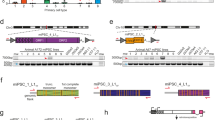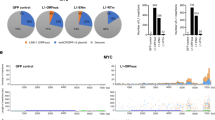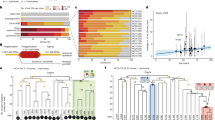Abstract
Long interspersed elements (LINEs) are endogenous mobile genetic elements1,2,3,4 that have dispersed and accumulated in the genomes of higher eukaryotes via germline transposition, with up to 100,000 copies in mammalian genomes. In humans, LINEs are the major source of insertional mutagenesis, being involved in both germinal and somatic mutant phenotypes4. Here we show that the human LINE retrotransposons, which transpose through the reverse transcription of their own transcript2, can also mobilize transcribed DNA not associated with a LINE sequence by a process involving the diversion of the LINE enzymatic machinery by the corresponding mRNA transcripts. This results in the ‘retroposition’ of the transcribed gene and the formation of new copies that disclose features characteristic of the widespread and naturally occurring processed pseudogenes: loss of intron and promoter, acquisition of a poly(A) 3′ end and presence of target-site duplications of varying length5,6. We further show–by introducing deletions within either coding sequence of the human LINE–that both ORFs are necessary for the formation of the processed pseudogenes, and that retroviral-like elements are not able to produce similar structures in the same assay. Our results strengthen the unique versatility of LINEs as genome modellers.
This is a preview of subscription content, access via your institution
Access options
Subscribe to this journal
Receive 12 print issues and online access
$209.00 per year
only $17.42 per issue
Buy this article
- Purchase on SpringerLink
- Instant access to full article PDF
Prices may be subject to local taxes which are calculated during checkout





Similar content being viewed by others
References
Jensen, S. & Heidmann, T. An indicator gene for detection of germline retrotransposition in transgenic drosophila demonstrates RNA-mediated transposition of the LINE I element. EMBO J. 10, 1927–1937 (1991).
Moran, J.V. et al. High frequency retroposition in cultured mammalian cells. Cell 87, 917–927 (1996).
Boeke, J.D. & Stoye, J.P. Retrotransposons, endogenous retroviruses, and the evolution of retroelements. in Retroviruses (eds Coffin, J.M., Hughes, S.H. & Varmus, H.E.) 343– 435 (Cold Spring Harbor Laboratory Press, Cold Spring Harbor, 1997).
Kazazian, H.H.J. & Moran, J.V. The impact of L1 retrotransposons on the human genome. Nature Genet. 19, 19–24 (1998).
Vanin, E.F. Processed pseudogenes: characteristics and evolution. Annu. Rev. Genet. 19, 253–272 ( 1985).
Weiner, A.M., Deininger, P.L. & Efstratiadis, A. Nonviral retroposons: genes, pseudogenes, and transposable elements generated by the reverse flow of genetic information. Annu. Rev. Biochem. 55, 631–661 (1986).
Heidmann, O. & Heidmann, T. Retrotransposition of a mouse IAP sequence tagged with an indicator gene. Cell 64, 159–170 (1991).
Maestre, J., Tchénio, T., Dhellin, O. & Heidmann, T. mRNA retroposition in human cells: processed pseudogene formation. EMBO J. 14, 6333–6338 ( 1995).
Dombroski, B.A., Mathias, S.L., Nanthakumar, E., Scott, A.F. & Kazazian, H.H. Isolation of an active human transposable element. Science 254, 1805– 1808 (1991).
Dhellin, O., Maestre, J. & Heidmann, T. Functional differences between the human LINE retrotransposon and retroviral reverse transcriptases for in vivo mRNA reverse transcription. EMBO J. 16, 6590–6602 (1997).
Kazazian, H.H.J. An estimated frequency of endogenous insertional mutations in human. Nature Genet. 22, 130 (1999).
Moran, J.V., DeBerardinis, R.J. & Kazazian, H.H. Jr Exon shuffling by L1 retrotransposition. Science 283, 1530–1534 (1999).
Eickbush, T. Exon shuffling in retrospect. Science 283, 1465–1467 (1999).
Brosius, J. Retroposons–seeds of evolution. Science 15, 753 (1991).
Lahn, B.T. & Page, D.C. Retroposition of autosomal mRNA yielded testis-specific gene family on human Y chromosome. Nature Genet. 21, 429–433 ( 1999).
Finnegan, D.J. The I factor and I-R hybrid dysgenesis in Drosophila melanogaster. in Mobile DNA (eds Berg, D.E. & Howe, M.M.) 503– 517 (American Society for Microbiology, Washington, DC, 1989).
Boeke, J.D. LINEs and Alu–the polyA connection. Nature Genet. 16, 6–7 (1997).
Tchénio, T., Ségal-Bendirdjian, E. & Heidmann, T. Generation of processed pseudogenes in murine cells. EMBO J. 12, 1487– 1497 (1993).
Klenerman, P., Hengartner, H. & Zinkernagel, R.M. Anon-retroviral RNA virus persists in DNA form. Nature 390, 298–301 ( 1997).
Weiss, R.A. & Kellam, P. Illicit viral DNA. Nature 390, 235–236 ( 1997).
Gabriel, A. & Teng, S.-C. LCMV cDNA formation: which reverse transcriptase is responsible? Trends Genet. 14, 220–221 (1998).
Carlton, M.B., Colledge, W.H. & Evans, M.J. Generation of a pseudogene during retroviral infection. Mamm. Genome 6, 90–95 (1995).
Boeke, J.D., Garfinkel, D.J., Styles, C.A. & Fink, G.R. Ty elements transpose through an RNA intermediate. Cell 40, 491–500 (1985).
Dornburg, R. & Temin, H.M. cDNA genes formed after infection with retroviral vector particles lack the hallmarks of natural processed pseudogenes. Mol. Cell. Biol. 10, 68– 74 (1990).
Levine, K.L. et al. Unusual features of integrated cDNAs generated by infection with genome-free retroviruses. Mol. Cell. Biol. 10, 1891–1900 (1990).
Derr, L.K., Strathern, J.N. & Garfinkel, D.J. RNA-mediated recombination in S. cerevisiae. Cell 67, 355–364 (1991).
Martin, S.L. Ribonucleoprotein particles with LINE-1 RNA in mouse embryonal carcinoma cells. Mol. Cell. Biol. 11, 4804– 4807 (1991).
Hohjoh, H. & Singer, M. Cytolasmic ribonucleoprotein complexes containing human LINE-1 protein and RNA. EMBO J. 15 , 630–639 (1996).
Sandmeyer, S. Targeting transposition: at home in the genome. Genome Res. 8, 416–418 (1998).
Kim, J.M., Vanguri, S., Boeke, J.D., Gabriel, A. & Voytas, D.F. Transposable element and genome organisation: a comprehensive survey of retrotransposons revealed by the complete Saccharomyces cerevisiae genome sequence. Genome Res. 8, 464 –478 (1998).
Acknowledgements
We thank H. Kazazian for the LINE pL1.2A plasmid; F. Dautry for the CMV-β-globin plasmid; O. Dhellin for constant help and advice; L. Bénit for help with computer searches; and C. Lavialle for comments and critical reading of the manuscript. This work was supported by the CNRS and a grant from the ARC to T.H.
Author information
Authors and Affiliations
Corresponding author
Rights and permissions
About this article
Cite this article
Esnault, C., Maestre, J. & Heidmann, T. Human LINE retrotransposons generate processed pseudogenes. Nat Genet 24, 363–367 (2000). https://doi.org/10.1038/74184
Received:
Accepted:
Issue Date:
DOI: https://doi.org/10.1038/74184



